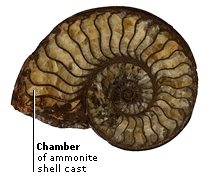DK Science: Turning To Stone
Most fossils are more than 10,000 years old, but many date back to the beginnings of life on Earth. Fossils are formed when animal or plant remains have been buried for millions of years. During this time, the remains change as minerals from the surrounding rock replace the minerals that make up the animal or plant. These changes happen so slowly that the remains keep their original shape. Most dinosaur skeletons are found in desert sandstones, after they have been buried by sandstorms, or in beds of rivers where river sand and mud have quickly covered them up.
Some fossils contain some of the original organic material. Leaves compressed in beds of shale or mudstone often decay slowly. They are made up of the elements carbon, hydrogen, and oxygen. The hydrogen and oxygen are lost to the air, but the carbon may be left as a thin film on the rock. These films are usually in the shape of the leaf. Fossilized plant material piled up into thick beds forms coal seams.
A particularly detailed fossil is formed by a process called petrification. This happens when groundwater replaces bone or wood with a mineral such as silica. The cells of the bone or wood are gradually replaced, molecule by molecule, over millions of years. The resulting fossil, even though it may be made of silica, still has the cellular structure of the original, and allows scientists to examine its finest details.
Sometimes a fossil rots away completely as the surrounding rock turns to stone. This may leave a hole, called a mould, in the rock in the exact shape of the fossil. If this mould is later filled with minerals, it forms a lump in the shape of the original called a cast. A beautiful cast forms when the natural spaces in an organism, such as the chambers of this ammonite shell, are filled with minerals.
When a fossil forms in a rock, it usually does so along the surface between two beds of the rock – the bedding plane. If the rock is split along this bedding plane, there may be part of the fossil on one piece of rock and part on the other. These two pieces of fossil are known as part and counterpart. Both are important to the palaeontologist, as together they will help reveal how the animal lived its life.
In more recent fossils, although the soft flesh and organs have disappeared, the hard parts of an animal – the shells, bones, or teeth –may have survived unchanged. Teeth are particularly hard as they are covered with enamel, and can survive even after the bones of the rest of the animal are lost.
To order this book direct from the publisher, visit DK's website.

